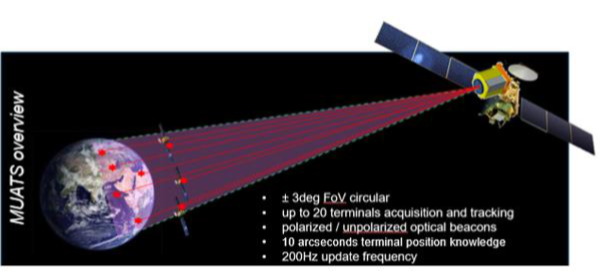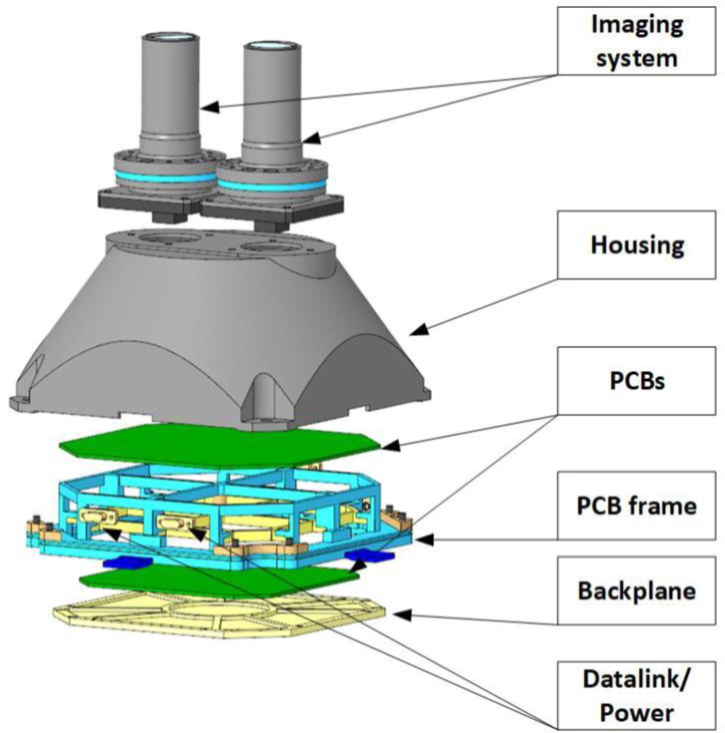-
StatusCompleted
-
Status date2022-12-15
-
Activity Code5G.006/SL0
Optical communication terminals (OCT) use laser beams to transfer data (e.g. Earth observation data) with high data rates from low-Earth orbit (LEO) satellites to geostationary satellites, which then forward the data to ground stations on Earth.
State-of-the-art optical communication systems are tailored for one-on-one communication links with one counter terminal at a time, over link sessions from a few minutes to hours. Link acquisition times in the order of tens of seconds are acceptable in these scenarios. When multiple simultaneous links or subsequent short duration links are required, this concept fails, as the acquisition time becomes significantly long compared to the link duration.
This is the case for ultra-high throughput satellites that implement multiple optical user access scenarios (e.g. constellations or airborne applications), as well as Galileo next-generation GNSS satellites. In addition, this is highly applicable to optical feeder links, as they require uninterrupted handover between multiple optical ground stations.
MUATS addresses the above described shortcoming of current optical link acquisition methods as well as acquisition and tracking sensors concepts for optical communication terminals (OCT).

Optical communication terminals operate in NIR and SWIR wavelength ranges. For these wavelengths camera matrix detectors are rare and provide low resolutions (e.g. 640 x 512 pixels).
The first challenge is to find a detector for NIR and SWIR wavelengths that provide sufficient properties to achieve the required terminal position knowledge at the fully required field of view.
The required framerate of 200 Hz is the second challenge. The detector design has to provide the full frame readout capability of 200 Hz, which affects heavily the electronic architecture for this concept, in particular the FPGA and software performances.
The third challenge in the frame of this activity is the realization of a breadboard, which is able to demonstrate performance through measurement of representative simulated targets. This implies the determination and use of optimized algorithms for detection and tracking of the targets.
MUATS shall provide the real-time angular position information to the optical heads (e.g. the satellite can have one or multiple transmit terminals/transmit optical heads) to allow uninterrupted handover from one airborne or ground OCT asset to the next.
The MUATS sensor concept is designed as a fully passive assistance system for laser communication terminals to be installed on GEO satellites.
Its task is to assist one or multiple accompanying OCTs with one optics. It enables the capability to detect, acquire and track of up to 20 counter OCTs and provide their angular position information at a rate of 200 Hz to the accompanying OCT. With this information, the accompanying OCT is going to be able to establish communication links between individual counter terminals and exchange data rapidly.
This allows the satellite to have a close to 100% use of the time for data transmission by offloading the acquisition and tracking fully to the MUATS sensor developed by Jena-Optronik.
MUATS key features:
-
Provide a field of view of +/-3° from geostationary orbit
-
Terminal position knowledge <10 arcsec
-
Operational wavelength: 1064nm or 1533nm or 1590nm
-
Allow beacon or beaconless spatial acquisition mode
-
Tracking up to 20 OCT users with high frame rate (200Hz)
-
Sufficient optical resolution to allow fast switching for the OCT
MUATS is designed as a single box and accommodates:
-
2 identical, rad-hard refractive telescope optics
-
2 InGaAs detectors with dedicated electronics
-
and interleaved readout
-
1 FPGA with dedicated electronics, including power supply and SpaceWire customer interface

The concept envisages that all necessary H/W is provided in one mechanical enclosure to enable autonomous operation and a simple redundancy concept. It considers the idea of interleaved detector readout regimes between two detectors, in order to reach a higher framerate with high resolution.
The MUATS concept study has furthermore provided a technical demonstrator (breadboard) based on commercial electronics and optics. The data processing has been realised with a standard PC.
The MUATS concept study started in April 2021 and ended in November 2022.
All activities have been completed, including:
-
Definition of a technical baseline and creation of a detailed design
-
Demonstration of functionalities and performance per simulations and analyses
-
Implementation and development of a technical demonstrator (Breadboard), realization of a test campaign to demonstrate compliance to the technical requirements
-
Assessment of the potential for commercial application and creation of a product development plan for raising TRL to qualification/flight model.
The project is now completed.


